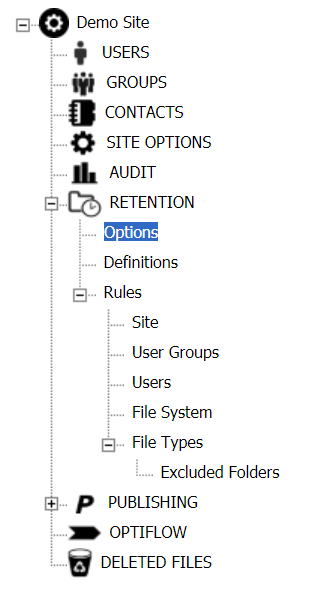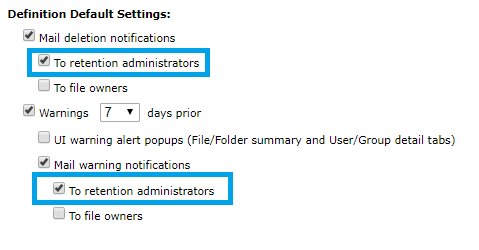Modifying retention rules best practices
To manage storage and comply with new industry regulations or internal policies, the rules must be changed and a new definition used.
Before updating retention policies, organizations often need to understand the potential impact of the changes. It is essential to know how many files will be affected or tagged for removal under the new retention policy.”
- Go to the RETENTION in the Administration portal.

- Temporarily turn off the automated file deletion for all rules so we can test the new rule definition in safe mode.
-
Ensure you set the Definition Default Settings to send all notifications to the retention administrators.
-
The retention administrators are the users in the RETENTION ADMINISTRATORS group.

- Change the retention rule by changing the retention definition for the rule.
For example, you can create a 30-day retention definition that will apply to the site-level rule.

- Select the new definition in the rule. For example, you can change the default site rule from 90-day retention to 30-day retention.

-
Make sure that the Automatic File Deletion is not enabled. This is also a safeguard on the rule to block any files from being deleted.
-
We wait for the retention rule to run once these changes are completed.
-
Since we set the frequency to 1 hour, you should expect the results in approximately 1 hour.
The system sends an email to all the Retention Administrators.
- Ensure you can receive emails from notifications@thruinc.net.
For example, the email message reports that the retention system will delete 469 files on the site due to the definition of the new site rule.
A report is also made available via a link that can be accessed in the Alerts.
Accessing this report displays the details of the files tagged for deletion.
The report also provides filters that enable you to drill down for specific folders, files, and file owners.
This report can be exported to Microsoft Excel, where additional summary fields can be added to reveal the total amount of storage that would be saved and the total number of files that would be deleted.

